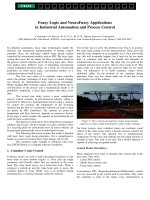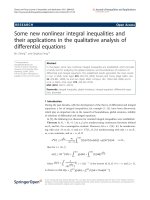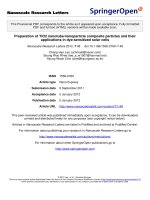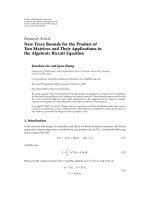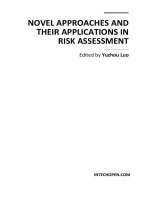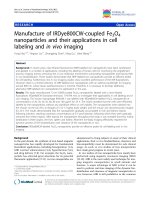NOVEL APPROACHES AND THEIR APPLICATIONS IN RISK ASSESSMENT doc
Bạn đang xem bản rút gọn của tài liệu. Xem và tải ngay bản đầy đủ của tài liệu tại đây (22.09 MB, 354 trang )
NOVELAPPROACHESAND
THEIRAPPLICATIONSIN
RISKASSESSMENT
EditedbyYuzhouLuo
Novel Approaches and Their Applications in Risk Assessment
Edited by Yuzhou Luo
Published by InTech
Janeza Trdine 9, 51000 Rijeka, Croatia
Copyright © 2012 InTech
All chapters are Open Access distributed under the Creative Commons Attribution 3.0
license, which allows users to download, copy and build upon published articles even for
commercial purposes, as long as the author and publisher are properly credited, which
ensures maximum dissemination and a wider impact of our publications. After this work
has been published by InTech, authors have the right to republish it, in whole or part, in
any publication of which they are the author, and to make other personal use of the
work. Any republication, referencing or personal use of the work must explicitly identify
the original source.
As for readers, this license allows users to download, copy and build upon published
chapters even for commercial purposes, as long as the author and publisher are properly
credited, which ensures maximum dissemination and a wider impact of our publications.
Notice
Statements and opinions expressed in the chapters are these of the individual contributors
and not necessarily those of the editors or publisher. No responsibility is accepted for the
accuracy of information contained in the published chapters. The publisher assumes no
responsibility for any damage or injury to persons or property arising out of the use of any
materials, instructions, methods or ideas contained in the book.
Publishing Process Manager Vana Persen
Technical Editor Teodora Smiljanic
Cover Designer InTech Design Team
First published April, 2012
Printed in Croatia
A free online edition of this book is available at www.intechopen.com
Additional hard copies can be obtained from
Novel Approaches and Their Applications in Risk Assessment, Edited by Yuzhou Luo
p. cm.
ISBN 978-953-51-0519-0
Contents
Preface IX
Section 1 Risk Assessment in Environmental and Ecosystem Quality 1
Chapter 1 A Practical Example of
Risk Assessment – Risk Assessment to Phycotoxins
in a Recreational Shellfish Harvester’s Subpopulation 3
Cyndie Picot and Alain-Claude Roudot
Chapter 2 Spatial Cadmium Distribution in the Charente
Watershed and Potential Risk Assessment for
the Marennes Oleron Bay (Southwest France) 21
Coynel Alexandra, Khoury Alaa, Dutruch Lionel,
Blanc Gérard, Bossy Cécile, Derriennic Hervé
and Schäfer Jörg
Chapter 3 Planning and Decision Support Tools for
Integrated Water Resources Management
(IWRM) on River Basin Level in the Southeast-Asian
Region on the Example of Vietnam –
Tools for Water Quantity and Quality Risk Assessment 37
Björn Zindler, Andreas Borgmann, Sandra Greassidis,
Sylvia Jaschinski, Christian Jolk and Harro Stolpe
Chapter 4 Risk Assessment of Cyanobacteria
and Cyanotoxins, the Particularities and
Challenges of Planktothrix spp. Monitoring 59
Catarina Churro, Elsa Dias and Elisabete Valério
Chapter 5 Generalized Additive Models in
Environmental Health: A Literature Review 85
Jalila Jbilou and Salaheddine El Adlouni
Chapter 6 The Science and
Opportunity of Wildfire Risk Assessment 99
Matthew P. Thompson, Alan A. Ager, Mark A. Finney,
Dave E. Calkin and Nicole M. Vaillant
VI Contents
Chapter 7 Theories and Methods for
the Emergency Rescue System 121
Jianfeng Li, Wenmao Liu and Bin Zhang
Chapter 8 Absorption and Accumulation of
Heavy Metal Pollutants in Roadside Soil-Plant
Systems – A Case Study for Western Inner Mongolia 157
Lu Zhanyuan, Zhi Yingbiao, Wang Zai-lan, Hua Yupeng,
Hong Ge, Emmy Camada and Yao Yiping
Section 2 Risk Assessment in Human Health 165
Chapter 9 Non-Invasive Matrices Use in Pollution
Evaluation at Nanoscale Levels – A Way
Forward in Ecotoxicological Studies 167
Melinda Haydee Kovacs, Dumitru Ristoiu and Cezara Voica
Chapter 10 Polysystemic Approach to Risk Assessment 185
Mikhail Karganov, Irina Alchinova and Nadezhda Khlebnikova
Chapter 11 Risk Assessment in the Anaesthesia Process 205
Valérie Neyns, Ophélie Carreras, Laurie Planes and Jean-Marie Cellier
Chapter 12 Effects of Wearing Gloves and Sex on
Endurance Time and the Corresponding
Finger Skin Temperature During a Cold Immersion 229
Yuh-Chuan Shih and Yo-May Wang
Section 3 Risk Assessment in System Design 243
Chapter 13 Risk Analysis of the Waste to Energy
Pyrolysis Facility Designs for City of
Konin, in Poland, Using SimLab
®
Toolpack 245
Boguslaw Bieda
Chapter 14 Methodology Applied to the
Diagnosis and Monitoring of Dikes and Dams 263
Yannick Fargier, Cyrille Fauchard, Patrice Mériaux,
Paul Royet, Sergio Palma-Lopes, Daniel François,
Philippe Côte and Fréderic Bretar
Chapter 15 Transforming Risk Assessment
Tools from Paper to Electronic 281
Daniel Bergeron and Kristiina Hyrkäs
Chapter 16 A Bayesian Approach for
Calibrating Risk Assessment Models 297
Michael S. Williams, Eric D. Ebel, Jennifer A. Hoeting
and James L. Withee
Contents VII
Chapter 17 Polynomial Response Surfaces for Probabilistic
Risk Assessment and Risk Control via Robust Design 317
Sergey Oladyshkin and Wolfgang Nowak
Preface
This book compiles chapters written by researchers who focus on the development
andapplicationofriskassessmentapproachesinvarioussubjectsofhydrology,water
quality,humanhealth,andindustrialdesigning.
Riskassessmentisacriticalcomponentin the evaluationandprotectionof natural or
anthropogenic systems. Conventionally, risk assessment is
involved with some
essential steps such as the identification of problem, risk evaluation, and assessment
review. Other novel approaches are alsodiscussedin the bookchapters. This book is
compiled to communicate the latest information on risk assessment approaches and
their effectiveness. Presented materials cover subjects from environmental quality to
human
healthprotection.
It’stheeditor’sexpectationthatthechaptersenclosedinthisbookwillprovidehelpful
informationforriskassessmentinbothacademicandindustrialfields,andencourage
the development and implementation of relevant applications for the protection of
environmentandhumanhealth.
YuzhouLuo,Ph.D.
DepartmentofLand,Air
andWaterResources
UniversityofCalifornia(Davis)
USA
Section 1
Risk Assessment in
Environmental and Ecosystem Quality
1
A Practical Example of Risk
Assessment – Risk Assessment
to Phycotoxins in a Recreational
Shellfish Harvester’s Subpopulation
Cyndie Picot and Alain-Claude Roudot
Laboratoire de Toxicologie Alimentaire et Cellulaire (EA 3880),
Université Européenne de Bretagne, Université de Bretagne Occidentale (UEB-UBO)
France
1. Introduction
The past few decades have seen an increase in the frequency, concentrations, and
geographic distribution of marine algal toxins (phycotoxins), secondary metabolites
produced by marine microalgae (phytoplankton). Among the 3400–4000 known
phytoplankton species, only about 2 % are potentially harmful (Frémy & Lassus, 2001).
Bivalve molluscs filter-feed on these micro-algae, accumulate toxins, and may be consumed
by humans (Shumway et al,. 1995; Van Dolah, 2000). In order to determine whether
phycotoxins are a matter of concern for human health, a risk assessment must be
undertaken. It comprises four steps: hazard identification, hazard characterization, exposure
assessment and risk characterization (WHO, 1985).
2. Risk assessment
Hazard identification is defined as follows: “the identification of biological, chemical and
physical agents capable of causing adverse health effects and that may be present in a
particular food or group of foods” (CAC, 2006). The outcome is a scientific judgment as to
know whether the chemical being evaluated could, under given exposure conditions, cause
an adverse effect in humans. In view of reported intoxications and deaths, phycotoxins are
identified as a matter of concern for human health. Because of their high and increasing
occurrence, their worldwide distribution and their different profile of toxicology and
contamination, this chapter focused on two families of phycotoxins: okadaic acid (OA) and
analogs, and spirolide (SPX) and analogs (Ade et al., 2003; Hallegraeff, 2003; EFSA, 2008a ;
EFSA, 2010).
Hazard characterization (also known as dose–response assessment) is defined as: “the
qualitative and/or quantitative evaluation of the nature of the adverse health effects
associated with biological, chemical, and physical agents that may be present in food”
(CAC, 2006). It describes the relationship between the ingested quantity of the substance
and the incidence of an adverse health effect (CAC, 2006). The aim is to allocate two
Novel Approaches and Their Applications in Risk Assessment
4
toxicological reference values: the Acute Reference Dose (ARfD) and the Tolerable Daily
Intake (TDI) for acute and chronic risks, respectively. The ARfD and the TDI are the amount
of a substance, in mg/kg bw, which can be ingested without adverse health effects, for one
meal or on a daily basis during a life time, respectively. Concerning acute hazard
characterization, based on human and animal data, provisional ARfD have been allocated to
OA, but a lack of data does not allow to allocate an ARfD to SPX. Moreover, concerning
chronic hazards, the lack of (sub)chronic data for animals prevented international expert
committees from allocating TDI to these toxins (Toyofuku, 2006; EFSA, 2008a; EFSA, 2010).
Exposure assessment is the evaluation of the likely intake of chemicals via food. It combines
the level of the chemical in the diet and the consumption rates of the foods containing the
chemical (Kroes et al., 2002; EFSA, 2008b). Exposure assessment must firstly concern at risk
subpopulation. Recreational shellfish harvesters appear to be an at risk subpopulation
because a priori they consumed a larger quantity of seafood than the general population,
because their practice is both recreational and a free source of food (Burger et al., 1998,
Gagnon et al., 2004; Leblanc, 2006). Unfortunately the shellfish harvester subpopulation is
generally not taken into account (USEPA, 1998) and no exposure assessment to phycotoxins
by recreative shellfish harvesters is available. Indeed, achieving a meaningful exposure
assessment on phycotoxins by recreational shellfish harvesters is extremely difficult because
of: i) the consumption data often do not distinguish between fish and shellfish, between
purchased shellfish and recreationally harvested shellfish between the general population
and specific subpopulations, and between shellfish species; ii) the contamination data reveal
great variations between shellfish species, toxin profiles, inter- and intra-country levels; iii)
consumption and contamination data are derived from different and unrelated studies.
Therefore it is critical to assess the phycotoxin dietary intakes from shellfish consumption in
this at risk subpopulation. These considerations led us to monthly monitor these
phycotoxins in harvested shellfish and to conduct a one-year survey of shellfish
consumption by recreational shellfish harvesters. Then these data were combined with a
probabilistic method to assess the exposure.
In the risk characterization phase, acute and chronic exposure intakes are compared with
ARfD and TDI, respectively, to assess whether or not the presence of contaminant is a
matter of concern (WHO, 1985).
3. Practical example: Risk assessment to phycotoxins in a recreational
shellfish harvester’s subpopulation
3.1 Hazard identification
Tibbetts (1998) assesses than phycotoxins could be responsible for some 60,000 incidents per
year the world over with an overall mortality rate of 1.5%. Incidence and severity are
different according to types of toxins. Thus, in view of reported intoxications and deaths,
phycotoxins are identified as a matter of concern for human health.
3.1.1 Okadaic acid and analogs
Okadaic acid (OA) and its congeners (dinophysistoxins) are produced by two species of
dinoflagellates Dynophisis spp and Prorocentrum spp (Hallegraeff, 2003). Historically, OA
A Practical Example of Risk Assessment – Risk Assessment to
Phycotoxins in a Recreational Shellfish Harvester’s Subpopulation
5
and analogs are classified in Diarrheic Shellfish Poisoning (DSP) because of the symptoms
they cause (gastrointestinal distress, diarrhea, nausea, vomiting and abdominal pain). Prior
to the 1980’s DSP incidents affected mainly Europe (first outbreak in 1961 in the
Netherlands) and Japan (the second incident is reported in Japan in the late 1970’s), whereas
currently diarrheic shellfish toxin outbreaks are documented all over the world. Tens of
thousands cases of intoxication have been reported (Picot et al., 2011a), all over the world,
but because of nonspecific clinical symptoms, DSP cases are probably underdiagnosed and
underreported (Economou et al., 2007). No death has been attributed to OAs.
3.1.2 Spirolides
Spirolides (SPXs) are cyclic imines produced by the dinoflagellate Alexandrium ostenfeldii.
SPXs are included in the “emerging toxin” group because they have been recently isolated
and characterised: in early 1990s, (in scallops and mussels harvested in Nova Scotia,
Canada) (Hu et al., 1995). In Europe SPXs have only recently been found in their producer
dinoflagellate and/or shellfish in Scotland, Italy, Denmark, Ireland, Norway, Spain and
France (in the 2000s). Nowadays, no report of human illness due to SPXs, have been
identified. Episodes of toxicity, involving non-specific symptoms such as gastric distress and
tachycardia were recorded in individuals in Nova Scotia, (Canada) consuming shellfish
during times when SPXs were known to be present, but these could not be definitively
ascribed to SPXs and are not consistent with the signs of toxicity in mice (Richard et al.,
2001). In mice, acute toxicity of SPXs is characterised by the rapid onset of systemic
neurotoxicity following i.p. (intra-peritoneal) injection and death within minutes. Thus SPXs
are therefore often denoted “fast acting toxins”.
3.2 Hazard characterization
As mentioned before, the aim is to allocate two toxicological reference values: the ARfD and
the TDI for acute and chronic risks, respectively. The two international organizations which
have evaluated toxicological studies and proposed these toxicological reference values are:
the JECFA (Joint FAO/WHO (Food and Agriculture Organization / World Health
Organization) Expert Committee on Food Additives) ad hoc Expert Consultation on
Biotoxins in Bivalve Molluscs and the European Food Safety Authority (EFSA).
3.2.1 Okadaic acid and analogs
Human data from Japan (eight people from three families, ages 10–68) indicate a LOAEL
(Lowest Observed Adverse Effect Level) of 1.2–1.6 μg/kg bw. In a second study from
Norway, 38 of 70 adults were affected at levels ranging from 1.0 to 1.5 μg/kg bw (Aune and
Yndestad, 1993). Based on the LOAEL of 1.0 μg OA/kg bw and a chosen safety factor of 3
because of documented human cases involving more than 40 people and because DSP
symptoms are readily reversible, the JEFCA established a provisional ARfD of 0.33 μg OA
equ/kg bw. In 2008, the EFSA proposed an ARfD of 0.30 μg OA equ/kg bw based on a
LOAEL equals to 0.9 μg OA/kg bw and a chosen safety factor of 3 to the use of a LOAEL
instead of a NOAEL (No Observed Adverse Effect Level). The JECFA and the EFSA
determined that no TDI could be established because of insufficient data on the chronic
effects of OA (EFSA, 2008a; Toyofuku, 2006).
Novel Approaches and Their Applications in Risk Assessment
6
3.2.2 Spirolides
The toxins of the group of SPXs are characterised by binding to and blocking of AChR
receptors in the central- and peripheral nervous system including neuromuscular junctions.
The acute toxic signs have a rapid onset, in particular following i.p. (intra-peritoneal)
administration. With regard to oral toxicity the reported toxicity varies greatly depending
on whether the toxin is administered by gavage or in feed and whether the animal is fasted.
In general, gavage administration shows lower LD50 (Lethal Dose) values for the various
toxins. In humans, no quantitative data on toxicity exist. In view of the acute toxicity of SPXs
the EFSA considered that an ARfD should be established for the SPXs, but due to the lack of
adequate quantitative data on acute oral toxicity (i.e. no-observed-adverse-effect levels
(NOAELs)) this was not possible. However, the toxicology working group of the European
Union Community Reference Laboratory for marine biotoxins (CRLMB) had proposed a
guidance level of 400 μg sum of SPXs/kg shellfish meat (CRLMB, 2005; Pigozzi et al., 2008).
But currently there are no regulations on SPXs in shellfish in Europe or in other regions of
the world.
There are no long term studies on the group of SPXs in experimental animals. Thus no TDI
had been allocated to SPXs.
3.3 Exposure assessment
3.3.1 Input data
To determine recreational shellfish harvester exposure, shellfish contamination data have
to be combined with their shellfish consumption rates. These two kinds of data are
lacking. Consumption data often do not distinguish fish and shellfish consumption and
do not take into consideration harvested shellfish consumption. Moreover, getting base
levels of these phycotoxins i in the most concerned shellfish i.e. bivalve molluscs, is a
prerequisite to any phycotoxin-exposure assessment. Such data are missing because
shellfish contamination is only analysed in case of phytoplankton bloom. These
considerations led us to monthly monitor these phycotoxins in such species and to
conduct a one-year survey of shellfish consumption by recreational shellfish harvesters
from the same area (i.e. contamination- and consumption-data collected in the same area
and relative to the same subpopulation).
3.3.1.1 Shellfish consumption data
The population of interest was a group of recreational shellfish harvesters set along the
coasts of Finistère (Western Brittany, France, see figure 1).
Their shellfish consumption was investigated from February 2008 to February 2009 through
two complementary methods: a Food Frequency Questionnaire (FFQ) and a food diary. The
FFQ was conducted through face-to-face interviews at the harvesting sites. As this tool
provides long-term consumption data, but relies upon memory, this drawback was
counteracted by using the records versus time of each shellfish meal (with quantities) kept
in the food diary. Moreover, this diary gave additional information such as the origin of
consumed shellfish (harvest, shop, restaurant ), consumption by different household
members and the way shellfish had been prepared. Data were validated for bivalve and
gastropod groups (for more details, see Picot et al., 2011b). The consumption data about five
A Practical Example of Risk Assessment – Risk Assessment to
Phycotoxins in a Recreational Shellfish Harvester’s Subpopulation
7
of the most consumed bivalve species in the area of interest are expressed as follows in
Table 1: portion sizes and daily shellfish consumption rates (both with the mean and 95th
percentile (P95)) as well as the raw consumption in percentage.
Fig. 1. Description of the area of interest: Finistère, Western Brittany, France.
Mean P95 Mean P95 Mean P95 Mean P95
Oyster 20.3 36.6 172.8 1.68 7.58 27.2 34.4 102.4 2.02 8.12
97.8
Mussel 27.3 69.4 396.0 1.66 10.1 33.6 80.0 264.0 4.04 11.6
0.00
Cockle 63.7 109 271.5 3.15 13.8 2.6 2.7 nc 0.09 0.26
2.38
Carpet shell clam 74.6 73.7 259.5 2.43 10.7 4.7 3.2 nc 0.14 0.47
31.7
Razor clam 23.4 27.6 167.8 0.57 3.31 0.0 0.00 0.00 0.00 0.00
0.00
King scallop 0.39 0.13 nc 0.0012 nc 20.3 15.2 85.5 0.45 2.50 3.69
nc : not calculable because of an insufficient number of consumers.
Bivalve species
% of raw
consumption
% of
consumers
Consumption derived only from harvested bivalve
% of
consumers
Consumption derived only from purchased bivalve
Daily consumption
rate (g/day)
Daily consumption
rate (g/day)
Portion size
(g/portion)
Portion size
(g/portion)
Table 1. Shellfish consumption data according to shellfish species and origin (harvest or
purchase). Consumption rates derived from the total population, including non consumers.
3.3.1.2 Shellfish contamination data
To counteract the lack of databases about phycotoxin base levels in shellfish, samples were
harvested monthly, from June 2009 to June 2010, on beaches of Finistère selected from three
criteria: i) the presence of several bivalve species, ii) regular shellfish harvesters and iii)
regular phycotoxin events. The analyses were made on only two among the five bivalve
species, which had been previously identified as being either the most consumed species or
the most contaminated from a consumption survey and a test about inter-species variability
(Picot et al., submitted). OAs and SPXs were analysed after methanolic extraction from
samples, purification by solid phase extraction and quantification by High Performance
Liquid Chromatography – tandem mass spectrometry (HPLC-MS/MS) (Picot et al.,
submitted). The results of contamination are presented in the figures 2 and 3.
Novel Approaches and Their Applications in Risk Assessment
8
0
200
400
600
800
1000
1200
1400
1600
J
uly
2
009
A
ugus
t
S
e
ptembe
r
O
cto
b
er
N
ovember
D
ec
em
be
r
January
F
ebr
uary
M
arc
h
M
arch
April
M
ay
J
u
ne
J
uly
2
010*
[OAs] (ng/g)
OAs Oyster
OAs Mussel
Fig. 2. Okadaic Acid profile of contamination.
0
10
20
30
40
50
60
70
80
90
100
July 2009
August
Se
pt
ember
O
c
t
o
b
er
November
D
ecember
Ja
nuary
Februar
y
Ma
rc
h
M
arch
A
pril
M
ay
J
une
J
uly
2
010*
[SPX] (ng/g)
SPX Oyster
SPX Mussel
Fig. 3. Spirolides profile of contamination
A Practical Example of Risk Assessment – Risk Assessment to
Phycotoxins in a Recreational Shellfish Harvester’s Subpopulation
9
Contamination data are often left-censored because of the limits of detection (LOD) and
quantification (LOQ) of analytical methods. The GEMS/Food–Euro framework proposed
different treatments according to the prevalence of censored-data (WHO, 1995):
- the number of censored data is less than or equal to 60 %, then, the censored data are
replaced by the corresponding LOD or LOQ divided by 2 (T1);
- the number of censored data is greater than 60 % and then:
either the censored data are replaced by zero (T2a)
or they are replaced by the corresponding LOD or LOQ (T2b).
The contamination data are described in Table 2. As, for OAs, the censored data accounted
for more 60 % of values, zero and LOD (or LOQ) values were used in two separate
estimations of the distributions and calculations (mean, median, percentiles ). On the other
hand, as the censored values about SPXs were less than 60 %, they were replaced by the half
of the corresponding LOD or LOQ.
Table 2. Okadaic acid and spirolide contamination data set by shellfish species (ng/g)
according to the censored data treatment.
3.3.2 Exposure modelling
3.3.2.1 General mode exposure
An acute exposure corresponds to a short exposure to a harmful compound at high dose.
Let us consider a phycotoxin denoted by m. The acute phycotoxin exposure is the amount of
m ingested in a single meal. It is obtained by multiplying the edible portion size of one
shellfish species by the concentration of m in this portion. For each phycotoxin, acute intakes
were calculated individually for each shellfish species.
Chronic exposure is a repeated exposure to low, or very low, doses for a long time. The
chronic phycotoxin exposure is the amount of m ingested daily from the daily consumption
of all shellfish species. The general exposure model used, here, to assess individual
phycotoxin intake from shellfish consumption can be expressed as follows:
BW
PCRC
m
jjmj
E
)**(
where Em is the individual exposure (mg/kg bw/day) to the phycotoxin, m, from the
ingested shellfish species, j, Cmj is the concentration (mg/kg) of the same phycotoxin in the
edible portion of the same species, CRj is the daily consumption rate (kg/day) of this
species, Pj is the proportion of a given shellfish species in a consumer diet (unitless), and BW
is the consumer body weight (kg) assumed, in this study, to be 60 kg (USEPA, 2000).
T1 T2a T2b T1 T2a T2b T1 T2a T2b
DA
O
13
69 2
264 4
241
00
10 0
130
130
Median Max
Phycotoxin
< LOQ
(%)
< LOD
(%)
Number of
analyses (n= )
Bivalve
species
Mean
OAs Oysters 13 76.9 0 nc 31.0 38.7 nc 0.0 10.0 nc 200.6 200.6
OAs Mussels 13 61.5 0 nc 203.6 209.7 nc 0.0 10.0 nc 1423 1423
SPX Oysters 13 0 0 14.2 nc nc nc nc nc nc
SPX Mussels 13 15.4 0 15.5 nc nc nc nc nc nc
nc : non concerned; LOD : Limit Of Detection; LOQ : Limit Of Quantification; T1 : parameters are estimated after replacing values below LOD with LOD/2 and
valued lying between LOD and LOQ with (LOQ - LOD)/2; T2a : parameters are estimated after replacing values below LOD by zero and values below LOQ by
LOD; T2b : parameters are estimated after replacing the censored data by the corresponding LOD or LOQ.
Novel Approaches and Their Applications in Risk Assessment
10
The difference in acute- and chronic-exposure assessments stands in the consumption
parameter to be used: the former takes into account the portion size of a given shellfish
species, whereas the latter considers the daily consumption rate of all shellfish species.
In this study, focus was on five of the bivalve species the most consumed in the
geographical area under study: oysters, mussels, cockles, carpet shell clams and razor clams.
Moreover, the approach in use for exposure calculation usually depends on the nature of the
available data. This study was based on a probabilistic approach described in Kroes et al.
(2002) and briefly recalled hereafter.
3.3.2.2 Probabilistic approach
Given that a shellfish consumer will not eat, at each time, the same portion size and that the
toxin level in the eaten portion will not be alike, the probabilistic calculation considers all of
the combinations of phycotoxin occurrence and consumption data. Distributions for both
the food consumption data and the contamination data were used in the model to simulate
dietary intakes by repeatedly drawing random values for each input distribution. The
description of input variables in terms of distributions allows one to characterise their
variability and/or uncertainty. Monte Carlo simulation techniques are used by the model to
generate output distributions of dietary intakes liable to be ultimately considered in risk
characterization. Output distributions i) give several exposure data (mean, median,
minimum, maximum and all percentiles) and ii) include a comprehensive analysis of the
sensitivities of the resulting exposure with respect to uncertainties in parameters (Counil et
al., 2005; Kroes et al., 2002; Tressou et al., 2004).
Model assumptions
The subjective assumptions in use in our simulation model were about factors liable to affect
contamination rates such as regulatory limits, inter-species variability and cooking process.
Because of their possible impact on the results obtained in exposure assessments, they have
to be taken into account to generate the model outputs.
Given that recreational shellfish harvesters can transgress bans, in this study, only the
contamination distributions in purchased shellfish were right truncated at the regulatory
limits when they exist (0.16 μg/g for OAs), whereas distributions of harvested shellfish
contamination were not truncated (thus contamination higher than regulatory limits can be
used).
- Each phycotoxin level is species-specific since the contamination rates are bivalve
species-dependent, but the analyses were not made on all species. For each toxin,
contamination levels were monthly determined in only two species. For the other
ones, a 3-month preliminary study was conducted to gain insight into the variability
of inter-species contamination. It allowed us to evaluate, for each toxin, the
relationship between the levels of contamination in the most contaminated species
and in the other ones, (for more details, see Picot et al., submitted). According to these
results, a normal distribution was applied to the contamination levels in the species
under study to describe the distributions of the levels in the non-analysed bivalve
species.
A Practical Example of Risk Assessment – Risk Assessment to
Phycotoxins in a Recreational Shellfish Harvester’s Subpopulation
11
- As the phycotoxin levels are affected by the cooking process in use, this parameter has
to be considered. The analyses were made on raw bivalves. To take into account the
cooking process impact, for each toxin, the ratio between the phycotoxin rates in raw
samples and in cooked samples was determined in a preliminary study (for more
details, see Picot et al., submitted). Then, a Normal distribution reflecting the difference
between the raw and the cooked contamination rates was assigned to the contamination
levels of raw bivalves in order to obtain the cooked contamination based on the raw
contamination rates.
Model simulation
The @Risk package, version 4.5 (Palisade, USA) with the Microsoft Excel spreadsheet under
XP (Microsoft, USA) was used to perform risk analysis from Monte Carlo simulations and
probability distributions so as to develop the exposure model on taking into account
uncertainty and variability. Each simulation was run for 10 000 iterations to mimic the
inherent uncertainty in shellfish-contamination and -consumption as well as the uncertainty
in the mathematical process. The probability of existence of a phycotoxin in shellfish, its
level in the shellfish and the probability of human exposure were all outputs of the
mathematical model. To help in the identification of critical points in the process, the model
sensitivity was analysed.
3.3.3 Results (output data)
Acute- and chronic-exposures to each of the phycotoxins under study were assessed
through probabilistic approach. With this approach, the exposure assessment model
produced, for each phycotoxin, a probability density distribution of dietary intakes from all
the bivalves under study.
3.3.3.1 Acute exposure
Acute- exposure corresponds to the phycotoxin intake by an individual over a meal
composed of a single portion of bivalves. For each bivalve species, the exposure is, thus, the
quantity obtained by multiplying the portion size by the contamination data. Table 3
presents the main results about acute exposure issued from the probabilistic assessment.
ARfD: Acude Reference Dose. * Assuming a body weight equals to 60 kg.
a
According to the JECFA
(Joint FAO/WHO Expert Committee on Food Additives).
b
According to the EFSA (European Food
Safety Authority).
Table 3. Acute dietary intakes of okadaic acid and spirolide obtained by a probabilistic
approach and comparison with toxicological reference values for each bivalve species.
Mean Median P95 Mean Median P95
19.4 7.62 78.1 8.60 5.46 27.4
456 151 1912 26.0 13.3 94.8
702 243 2808 78.4 49.6 250
378 149 1466 19.8 12.3 60.00
133 44.9 569 8.58 5.50 27.2
17.7 7.1 72 8.10 5.21 25.5
183 79 706 29.9 15.6 105
4.00 1.7 18 1.90 1.20 6.00
3.80 1.5 15 0.7 0.45 2.20
000 000
333
a
/ 300
b
No ARfD allocated
OA
Exposure* (ng/kg.bw/portion)
SPX
Exposure* (ng/kg.bw/portion)
Harvested oysters
Harvested mussels
Harvested cockles
Harvested carpet shell clams
Harvested razor clams
Purchased oysters
Purchased mussels
Purchased cockles
Purchased carpet shell clams
Purchased razor clams
ARfD
Novel Approaches and Their Applications in Risk Assessment
12
Okadaic acid and analogs
Concerning OAs, the exposure distribution led to a maximal (for harvested cockles) mean
value, a median value and a 95th percentile value equal to 0.70, 0.24 and 2.81 μg/kg bw,
respectively. Figure 4 shows the acute exposure for each shellfish species.
Fig. 4. Acute exposure to Okadaic Acid (ng/kg bw) for each shellfish species.
Spirolides
For SPXs exposure distribution, the highest (for harvested cockles) mean value, median and
95th percentile were equal to 78.5, 49.6 and 250 ng/kg.bw, respectively. Figure 5 shows the
acute exposure for each shellfish species.
Fig. 5. Acute exposure to Spirolide (ng/kg bw) for each species.
Exposure (ng/kg bw)
Harvested
oysters
Harvested
mussels
Harvested
cockles
Harvested
hard shell
clams
Harvested
razor
Purchased
oysters
ss
Purchased
mussels
Purchased
cockles
Purchased
hard shell
clams
Purchased
razor
clams
Exposure (ng/kg bw)
Harvested
oysters
Harvested
mussels
Harvested
cockles
Harvested
hard shell
clams
Harvested
razor
Purchased
oysters
ss
Purchased
mussels
Purchased
cockles
Purchased
hard shell
clams
Purchased
razor
clams
A Practical Example of Risk Assessment – Risk Assessment to
Phycotoxins in a Recreational Shellfish Harvester’s Subpopulation
13
3.3.3.2 Chronic exposure
The chronic exposure assessment corresponds to the level of exposure after a daily
consumption of shellfish, thus the useful consumption data are the daily consumption rates.
Table 4 illustrates the chronic-exposure levels issued from the probabilistic exposure
approach for harvested-, purchased-bivalves and “all bivalves”.
ARfD: Acude Reference Dose. * Assuming a body weight equals to 60 kg.
a
According to the JECFA
(Joint FAO/WHO Expert Committee on Food Additives).
b
According to the EFSA (European Food
Safety Authority).
Table 4. Chronic dietary intakes of okadaic acid and spirolide obtained by a probabilistic
approach for harvested, purchased and all bivalves; and comparison with toxicological
reference values.
Okadaic acid and analogs
Concerning OAs, the “all bivalves”-related exposure distribution presents maximal means
of 54.1 and 56.2 ng/kg bw/day for T2a and T2b scenarios, respectively, as well as median
values of 39.0 and 41.1 ng/kg bw/day and 95th percentiles of 149 and 155 ng/kg bw/day.
One should note that the censored value scenario (T2a or T2b) has a very limited effect upon
the chronic dietary exposure to phycotoxins. About the comparison of the contribution by
harvested bivalves against the one by purchased bivalves, table 4 shows clearly that, for
OAs, the intakes derived from harvest are about 5-fold those derived from purchase, mainly
because the contamination distribution of harvested bivalves took into account levels above
the regulatory limit. The figure 6 shows the exposure distribution of OAs for all species.
Minimum 0,7084
Maximum 747,6885
Mean 54,1232
Median 38,9510
Std Dev 51,8726
Exposure (ng/kg bw/day)
Fig. 6. Chronic exposure distribution to Okadaic Acid (ng/kg bw/day) for all species.
Mean Median P95 Mean Median P95
44.4 29.3 134 3.5 2.8 8.3
9.70 5.10 34.5 1.9 1.3 5.70
54.1 39.0 149 5.4 4.60 11.9
45.9 30.9 137
10.3 5.40 36.6
56.2 41.1 155
333
a
/ 300
b
No ARfD allocated
No Tolerable Daily Intake allocated
OA SPX
Exposure* (ng/kg.bw/day) Exposure* (ng/kg.bw/day)
Censored
values Bivalve sources
treatment
Harvested bivalves
Purchased bivalves
All bivalves
Harvested bivalves
Purchased bivalves
All bivalves
ARfD
T1 (SPX) or
T2a (DA
and OA)
T2b
Tolerable Daily Intake
Novel Approaches and Their Applications in Risk Assessment
14
Spirolides
Concerning SPX, the chronic distribution of exposure (for “all bivalves”) leads to a mean
value of 5.4 ng/kg bw/day, a median of 4.6 ng/kg bw/day, and a 95th percentile of 11.9
ng/kg bw/day For SPX, the intakes derived from harvest are about 2-fold those derived
from purchase. The figure 7 shows the exposure distribution of OAs for all species.
Exposure (ng/kg bw/day)
Fig. 7. Chronic exposure distribution to Spirolide (ng/kg bw/day) for all species.
Species contribution
Figure 8 illustrates the contribution of each bivalve shellfish to the daily intakes of each of
the phycotoxin under study. It evidences that the three greatest contributor species are the
cockles and the carpet shell clams from harvest as well as the mussels from both harvest and
purchase. Their high contributions come from the high consumption and contamination
rates for harvested-species and to the high consumption rate for purchased mussels.
0,0
5,0
10,0
15,0
20,0
25,0
30,0
35,0
% of contribution
1,6
7,2
20,2
11,3
36,6
34,1
18,5
9,5
5,1
2,5
1,8
8,2
15,6
25,9
0,2
0,8
0,2
0,4
0,0 0,0
AO SPX
Harvested mussels
Harvested carpet shell clams
Purchased oysters
Purchased cockles
Purchased king scallops
Harvested oysters
Harvested cockles
Harvested razor clams
Purchased mussels
Purchased carpet shell clams
Fig. 8. Contribution of each bivalve species to the daily intakes of okadaic acid and spirolide
determined through the probabilistic approach (T2a and T1 treatments of censored values).
A Practical Example of Risk Assessment – Risk Assessment to
Phycotoxins in a Recreational Shellfish Harvester’s Subpopulation
15
3.4 Risk characterization
3.4.1 Acute risk characterization
For acute-risk characterization, probabilistic estimates of dietary exposure to phycotoxins
have to be compared to the ARfD (Acute Reference Dose). For OAs, the provisional ARfDs
established are 0.33 and 0.30 μg/kg bw by the JECFA and the EFSA, respectively, whereas
no ARfD has been allocated for SPX (Toyofuku, 2006).
3.4.1.1 Okadaic acid and analogs
Concerning OAs, the highest probabilistic assessment (for harvested cockles) led to a mean
exposure and a 95th percentile of, respectively, about 2.5-fold and 9-fold the OA ARfD, but
to a median exposure almost 1.25-fold less than the OA ARfD. One should note that, for
purchased bivalves, all exposures (means, medians and 95th percentiles) were below than
the OA ARfD, excepted for high consumers of mussels, they are above the acute reference
value.
3.4.1.2 Spirolides
Characterizing the SPX acute risk by comparison of the acute exposure with the ARfD
cannot be realized because of the unavailability of SPX ARfD value explained by the lack
of quantitative data on acute oral toxicity by this phycotoxin. However, only in order to
have an idea of the order of magnitude of the margin of exposure, the acute exposure
could be compared with the LD
0
(Lethal Dose)
1
. Munday (2008) studied acute oral
exposure to SPX by mice. In the case of oral administration of SPX to mice, it results in
two LD
0
equal to 53 and 400 µg/kg bw, for gavage and feeding with cheese cream
containing SPX, respectively.
In the case of the most representative way of administration (mice feeding with cheese
cream containing SPX), the highest probabilistic assessment (for harvested cockles) led to a
mean exposure and a 95th percentile of, respectively, about 5000-fold and 1600-fold less
than the SPX LD
0
. Comparing with the most protective LD
0
(= 53 µg/kg.bw), the highest
probabilistic assessment (for harvested cockles) led to a mean exposure and a 95th percentile
of, respectively, about 675-fold and 210-fold less than the SPX LD
0
.
Since the margin of exposure is higher than 100, it seems appear that acute SPX is not a
matter of concern for human health. But this conclusion has to be confirmed with other
relevant toxicological studies, allowing to establish an ARfD for SPX.
3.4.2 Chronic risk characterization
For chronic risk characterization, probabilistic estimates of dietary exposure to phycotoxins
have to be compared to the TDI. But, as no TDI has been allocated to phycotoxins by
international committees, we used two other methods, not satisfactory but the only ones
possible: comparison with the corresponding ARfD and with the Threshold of Toxicological
Concern (TTC). The TTC is a principle, which refers to the establishment of a human
exposure threshold value for all chemicals, below which there would be no appreciable risk
1
LD
0
(Lethal Dose 0): the amount of a chemical that if administered to an animal will kill 0 % of the
sample population.
